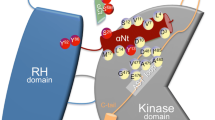Abstract.
Regulator of G-Protein Signaling (RGS) refers to a conserved 120–125 amino acid motif that was first identified by its ability to negatively regulate G-Protein-Coupled Receptor (GPCR) signalling. Mechanistically, RGSs were found to regulate GPCR responses by binding to and stimulating the GTPase activity of the receptor-activated GTP-bound G α subunits. There are now over 25 mammalian RGSs containing proteins that are reported to carry out a variety of functions, many of which are unrelated to GPCR signalling. RGS proteins range in size from small proteins that contain little more than an RGS box to very large proteins that contain a variety of domains. The selectivity of function of the RGS proteins is attributable to the divergence of the RGS sequences as well as the presence of a variety of functional motifs, which allow them to interact with other proteins. Here we focus on the RGSs that are involved in modulating GPCR signalling by reviewing the diversity of the mechanisms involved in regulating these RGSs.
Similar content being viewed by others
Author information
Authors and Affiliations
Corresponding author
Additional information
Received 9 February 2006; received after revision 4 May 2006; accepted 22 May 2006
Rights and permissions
About this article
Cite this article
Jean-Baptiste, G., Yang, Z. & Greenwood, M.T. Regulatory mechanisms involved in modulating RGS function. Cell. Mol. Life Sci. 63, 1969–1985 (2006). https://doi.org/10.1007/s00018-006-6066-y
Published:
Issue Date:
DOI: https://doi.org/10.1007/s00018-006-6066-y




